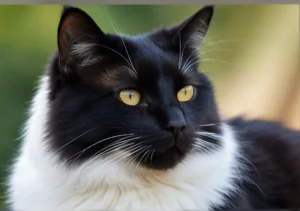Have you ever wondered why cats’ whiskers are so sensitive? Let’s explore the reasons behind this fascinating phenomenon.
Cats whiskers are extremely sensitive because they are deeply rooted in their bodies and connected to their nervous system. Here’s why:
Anatomy of Cats’ Whiskers
Cats’ whiskers, also known as vibrissae, are not just cute facial features; they serve a crucial sensory function for our feline friends. These specialized hairs are deeply rooted in the thick muscular layer of the cat’s face, making them incredibly sensitive to even the slightest touch or movement. Unlike regular hairs, whiskers are thicker and stiffer, thanks to a dense network of nerve endings at their base. This unique anatomical structure allows cats to perceive even the tiniest changes in their environment, making whiskers a vital tool in their survival kit.
Functions of Cats’ Whiskers
Cats whiskers may look like simple facial adornments, but they play a multitude of roles in a cat’s daily life. These remarkable sensors not only help our feline friends gauge the width of openings and pathways but also assist them in maintaining balance and coordination. If a cat’s whiskers are damaged or trimmed, they may struggle with spatial awareness and become disoriented. Additionally, whiskers aid cats in detecting air currents, alerting them to potential predators or prey in their surroundings.
Moreover, Cats’ whiskers can even reflect a cat’s mood or emotions. When a cat is feeling calm and relaxed, their whiskers are typically positioned forward. Conversely, if a cat is scared or threatened, their whiskers may flatten against their face as a defensive mechanism. By observing a cat’s whiskers, you can gain valuable insights into their state of mind and potentially avoid unnecessary stress for your furry companion.
Importance of Cats’ Whiskers in Communication
Cats’ whiskers may seem like just decorative features, but they play a crucial role in communication. When a cat is in a state of heightened emotion, their whiskers will move forward. This signals excitement, fear, or aggression to other animals. Additionally, cats use their whiskers to gauge the space around them. If their whiskers touch something, it alerts them to obstacles or potential danger. So, next time you see your cat’s whiskers twitching, remember they are sending and receiving important signals.
The Role of Whiskers in Hunting
Cats’ whiskers are not just for show – they are essential tools in their hunting arsenal. The sensitive nature of whiskers allows cats to navigate through tight spaces while stalking prey. When a cat is on the prowl, its whiskers help determine if they can fit through a gap without making a sound. This silent navigation is crucial for sneaking up on unsuspecting prey. So, the next time you watch your cat effortlessly sliding through a narrow space, remember it’s their whiskers at work, helping them be stealthy and precise in their movements.
Additional Unique Insight:
- Cats’ whiskers are roughly as wide as their body, allowing them to accurately judge if they can fit through tight spaces without getting stuck. This unique adaptation showcases the precision and efficiency of a cat’s whiskers in aiding their hunting instincts.
Mythbusting: Can Cats Feel Through Their Whiskers?
Let’s set the record straight: cats’ whiskers are not just there for decoration. These specialized vibrissae, as they’re scientifically called, are actually incredibly sensitive and serve a crucial purpose in a cat’s daily life. Contrary to popular belief, cats don’t have a magical ability to sense the paranormal through their whiskers. Instead, these whiskers are finely tuned sensory tools that help felines navigate their surroundings with precision and accuracy.
Cats’ whiskers are deeply rooted in their face and are connected to sensitive nerve endings, making them highly adept at picking up even the slightest changes in their environment. This sensitivity allows cats to gauge the size of openings, detect nearby objects in dim light, and even sense changes in air currents. So, the next time your cat deftly maneuvers through a narrow space, you can thank those remarkable whiskers for their role in guiding them.
Interesting Facts About Cats’ Whiskers
Did you know that cats’ whiskers are roughly as wide as their bodies? These specialized hairs are not just for show; they play a crucial role in helping cats navigate the world around them. Here are some intriguing facts about cats’ whiskers that shed light on their remarkable abilities:
- Whiskers are not just on the face: Whiskers can also be found on a cat’s legs and back, helping them gauge whether they can fit through certain spaces.
- Whiskers are a mood indicator: When a cat is content and relaxed, their whiskers will be positioned in a normal, relaxed state. However, if they are frightened or agitated, their whiskers will be pulled back close to their face.
- Whiskers are not to be trimmed: It’s essential never to trim a cat’s whiskers, as they rely on them for essential sensory information.
These fascinating tidbits offer a glimpse into the intricate and vital role that cats’ whiskers play in their daily lives.
Alex, a passionate animal lover, has experience in training and understanding animal behavior. As a proud pet parent to two dogs and three cats, he founded AnimalReport.net to share insights from animal experts and expand his knowledge of the animal kingdom.




